Plant Diversity Response to Environmental Factors in Yellow River Delta, China
Abstract
1. Introduction
2. Materials and Methods
2.1. Study Area and Soil Formation Age Division
2.2. Sampling Design and Field Survey
2.3. Biodiversity Index
2.3.1. Shannon–Wiener Index
2.3.2. Simpson Diversity Index
2.3.3. Pielou’s Evenness Index
2.4. Variable Data Source and Analysis Method
3. Results
3.1. Field Survey Results
3.1.1. Vegetation Diversity under Different Soil-Forming Ages
3.1.2. Vegetation Diversity under Different Land Cover Types
3.2. The Relationships between Impact Factors and Plant Diversity
3.3. Redundancy Analysis of Impact Factors and Plant Diversity
4. Discussion
4.1. Plant Diversity in the Yellow River Delta
4.2. The Effect of Salinity on Vegetation Biodiversity in the Yellow River Delta
4.3. The Impact of Vegetation Biomass Carbon on Biodiversity in the Yellow River Delta
5. Conclusions
Author Contributions
Funding
Data Availability Statement
Acknowledgments
Conflicts of Interest
References
- Li, S.; Wang, X.; Liu, H.; Sun, M.; Lei, Y. Diversity of Desert Plants in Hexi Corridor and Its Response to Environmental Factors. Ecol. Environ. Sci. 2023, 32, 429–438. [Google Scholar]
- Zhang, J.; Diao, H.; Zhang, T.; Diao, X. Dynamics of species diversity of communities in restoration processes in horqin sandy land. Acta Phytoecol. Sin. 2004, 28, 86–92. [Google Scholar]
- Lukacs, B.A.; Sramko, G.; Molnar, A.V. Plant diversity and conservation value of continental temporary pools. Biol. Conserv. 2013, 158, 393–400. [Google Scholar] [CrossRef]
- Weigel, R.; Gilles, J.; Klisz, M.; Manthey, M.; Kreyling, J. Forest understory vegetation is more related to soil than to climate towards the cold distribution margin of European beech. J. Veg. Sci. 2019, 30, 746–755. [Google Scholar] [CrossRef]
- Yao, M.; Guo, C.; He, F.; Zhang, Q.; Ren, G. Soil Stoichiometric Characteristics and its Relationship with Plant Diversity in Saline-Alkali Grassland of Northern Shanxi. Acta Agrestia Sin. 2021, 29, 2800–2807. [Google Scholar]
- Elser, J.J.; Sterner, R.W.; Gorokhova, E.; Fagan, W.F.; Markow, T.A.; Cotner, J.B.; Harrison, J.F.; Hobbie, S.E.; Odell, G.M.; Weider, L.J. Biological stoichiometry from genes to ecosystems. Ecol. Lett. 2000, 3, 540–550. [Google Scholar] [CrossRef]
- Cardinale, B.J.; Duffy, J.E.; Gonzalez, A.; Hooper, D.U.; Perrings, C.; Venail, P.; Narwani, A.; Mace, G.M.; Tilman, D.; Wardle, D.A.; et al. Biodiversity loss and its impact on humanity. Nature 2012, 486, 59–67. [Google Scholar] [CrossRef]
- Furey, G.N.; Tilman, D. Plant biodiversity and the regeneration of soil fertility. Proc. Natl. Acad. Sci. USA 2021, 118, e2111321118. [Google Scholar] [CrossRef] [PubMed]
- Hooper, D.U.; Adair, E.C.; Cardinale, B.J.; Byrnes, J.E.K.; Hungate, B.A.; Matulich, K.L.; Gonzalez, A.; Duffy, J.E.; Gamfeldt, L.; O’Connor, M.I. A global synthesis reveals biodiversity loss as a major driver of ecosystem change. Nature 2012, 486, 105–108. [Google Scholar] [CrossRef] [PubMed]
- Wardle, D.A.; Walker, L.R.; Bardgett, R.D. Response to comment on “Ecosystem properties and forest decline in contrasting long-term chronosequences”. Science 2005, 308, 633. [Google Scholar] [CrossRef]
- Lange, M.; Eisenhauer, N.; Chen, H.; Gleixner, G. Increased soil carbon storage through plant diversity strengthens with time and extends into the subsoil. Glob. Chang. Biol. 2023, 29, 2627–2639. [Google Scholar] [CrossRef]
- Lange, M.; Koller-France, E.; Hildebrandt, A.; Oelmann, Y.; Wilcke, W.; Gleixner, G. How plant diversity impacts the coupled water, nutrient and carbon cycles. In Mechanisms Underlying the Relationship between Biodiversity and Ecosystem Function; Eisenhauer, N., Bohan, D.A., Dumbrell, A.J., Eds.; Academic Press Inc., Elsevier Science: San Diego, CA, USA, 2019; Volume 61, pp. 185–219. [Google Scholar]
- Siles, G.; Voirin, Y.; Benie, G.B. Open-source based geo-platform to support management of wetlands and biodiversity in Quebec. Ecol. Inform. 2018, 43, 84–95. [Google Scholar] [CrossRef]
- Erdos, L.; Torok, P.; Veldman, J.W.; Batori, Z.; Bede-Fazekas, A.; Magnes, M.; Kroel-Dulay, G.; Tolgyesi, C. How climate, topography, soils, herbivores, and fire control forest-grassland coexistence in the Eurasian forest-steppe. Biol. Rev. 2022, 97, 2195–2208. [Google Scholar] [CrossRef] [PubMed]
- Deguines, N.; Brashares, J.S.; Prugh, L.R. Precipitation alters interactions in a grassland ecological community. J. Anim. Ecol. 2017, 86, 262–272. [Google Scholar] [CrossRef] [PubMed]
- Rita, A.; Borghetti, M. Linkage of forest productivity to tree diversity under two different bioclimatic regimes in Italy. Sci. Total Environ. 2019, 687, 1065–1072. [Google Scholar] [CrossRef] [PubMed]
- Kumar, B.M. Do carbon stocks and floristic diversity of tropical homegardens vary along an elevational gradient and based on holding size in central Kerala, India? Agrofor. Syst. 2023, 97, 751–783. [Google Scholar] [CrossRef] [PubMed]
- Yotkham, S.; Suttiprapan, P.; Likhitrakarn, N.; Sulin, C.; Srisuka, W. Biodiversity and Spatiotemporal Variation of Longhorn Beetles (Coleoptera: Cerambycidae) in Tropical Forest of Thailand. Insects 2021, 12, 45. [Google Scholar] [CrossRef] [PubMed]
- Dou, P.; He, S.; Gao, C.; Li, K.; Liu, F. Effects of different restoration communities on understory species diversity and soil physical and chemical properties in dry-hot valley. J. Zhejiang Af Univ. 2022, 39, 616–624. [Google Scholar]
- Hou, G.; Lai, J.; Li, J.; Liu, Z.; Gong, H.; Wang, B.; Sun, Z.; Ouyang, Z.; Hou, R. Driving force of soil age on vegetation and microbial succession in the Yellow River Delta. Acta Ecol. Sin. 2022, 42, 8839–8859. [Google Scholar]
- Bui, E.N. Soil salinity: A neglected factor in plant. ecology and biogeography. J. Arid. Environ. 2013, 92, 14–25. [Google Scholar] [CrossRef]
- Zhang, X.; Lv, G.; Yang, X.; Gong, L.; Qin, L.; He, X.; Liu, H. Responses of desert plant diversity, community and interspecific association to soil salinity gradient. Acta Ecol. Sin. 2013, 33, 5714–5722. [Google Scholar] [CrossRef]
- Wang, M.; Lu, N.; An, N.; Fu, B. Plant Functional and Phylogenetic Diversity Regulate Ecosystem Multifunctionality in Semi-Arid Grassland During Succession. Front. Environ. Sci. 2022, 9, 791801. [Google Scholar] [CrossRef]
- Zhou, G.; Lucas-Borja, M.E.; Liu, S.; Hu, H.-W.; He, J.-Z.; Wang, X.; Jiang, Z.; Zhou, X.; Delgado-Baquerizo, M. Plant and soil biodiversity is essential for supporting highly multifunctional forests during Mediterranean rewilding. Funct. Ecol. 2023, 37, 420–431. [Google Scholar] [CrossRef]
- Ali, M.; Yar, P.; Khan, S.; Muhammad, S.; Hussain, W.; Hussain, K.; Hussain, G.; Aneva, I.Y.; Tng, D.Y.P.; Bussmann, R.W. Land use and land cover modification and its impact on biodiversity and the ecosystem services in District Kurram, Pakistan. Bol. Latinoam. Y Caribe Plantas Med. Y Aromat. 2022, 21, 365–388. [Google Scholar]
- Martin, C.A.; Proulx, R.; Vellend, M.; Fahrig, L. How the relationship between vegetation cover and land-cover variance constrains biodiversity in a human dominated world. Landsc. Ecol. 2021, 36, 3097–3104. [Google Scholar] [CrossRef]
- Nemec, R.; Vymazalova, M.; Skokanova, H. The Impact of Fine-Scale Present and Historical Land Cover on Plant Diversity in Central European National Parks with Heterogeneous Landscapes. Land 2022, 11, 814. [Google Scholar] [CrossRef]
- Janousek, C.N.; Folger, C.L. Variation in tidal wetland plant diversity and composition within and among coastal estuaries: Assessing the relative importance of environmental gradients. J. Veg. Sci. 2014, 25, 534–545. [Google Scholar] [CrossRef]
- Qu, Z.; Li, Y.; Yu, J.; Yang, J.; Ma, Y.; Zhang, J.; Zhou, D.; Wang, X. Simulation of soil water and salt transportation of typical plant community in estuarine wetland of the Yellow River Delta. Chin. J. Ecol. 2022, 41, 903–911. [Google Scholar]
- Liping, G.; Erda, L. Carbon sink in cropland soils and the emission of greenhouse gases from paddy soils: A review of work in China. Chemosphere-Glob. Chang. Sci. 2001, 3, 413–418. [Google Scholar] [CrossRef]
- Hou, G.; Gao, M.; Ye, S.; Zhao, G. Source of salt and the salinization process of shallow groundwater in the Yellow River Delta. Earth Sci. Front. 2022, 29, 145–154. [Google Scholar]
- Guo, H.; Fan, Y.; Guan, Q.; Fan, B.; Wang, Y. Ecological risk assessment of the Yellow River Delta based on ecosystem services. Mar. Sci. 2023, 47, 15–26. [Google Scholar]
- Qu, Y.; Wang, S.; Li, Y.; Zhu, W.; Wang, S. Characteristics of potential conflicts of territorial space and optimization pattern in the Yellow River Delta based on multi-functional suitability. Sci. Geogr. Sin. 2023, 43, 301–312. [Google Scholar]
- Ma, D.; Huang, Q.; Liu, B.; Zhang, Q. Analysis and Dynamic Evaluation of Eco-Environmental Quality in the Yellow River Delta from 2000 to 2020. Sustainability 2023, 15, 7835. [Google Scholar] [CrossRef]
- Xu, Q.; Yang, J.; Yuan, G.; Chu, Z.; Zhang, Z. Stratigraphic sequence and episodes of the ancient Huanghe Delta along the southwestern Bohai Bay since the LGM. Mar. Geol. 2015, 367, 69–82. [Google Scholar] [CrossRef]
- Wang, J.; Wang, J.; Zhang, Z.; Li, Z.; Zhang, Z.; Zhao, D.; Wang, L.; Lu, F.; Li, Y.-Z. Shifts in the bacterial population and ecosystem functions in response to vegetation in the yellow river delta wetlands. Msystems 2020, 5, 1–14. [Google Scholar] [CrossRef]
- Fan, Y.; Wang, J.; Fan, B.; Xu, Z. Dynamic monitoring of wetlands in the Yellow River delta based on multi-source remote sensing. Bull. Surv. Mapp. 2023, 27–35. [Google Scholar]
- Wang, K.; Fan, Y.; Du, X.; Yu, S. Study on the classification of geomorphic unit in the Yellow River Delta. J. Sediment Res. 2021, 46, 51–57, 64. [Google Scholar]
- Zhang, Q.; Zhao, Z.; Jia, L.; Wang, W.; Jia, W. Analysis of land subsidence status and influencing factors in Yellow River Delta. Sci. Surv. Mapp. 2022, 47, 165–173. [Google Scholar]
- Zhang, X.; Cao, Q.; Ji, S.; Chen, H.; Zhang, T.; Liu, J. Quantifying the contributions of climate change and human activities to vegetation dynamic changes in the Yellow River Delta. Acta Sci. Circumstantiae 2022, 42, 56–69. [Google Scholar]
- Yue, X.Y.; Yue, W. The spatiotemporal characteristics of vegetation coverage and its driving factors in the Yellow River Delta. Appl. Ecol. Environ. Res. 2023, 21, 4165–4176. [Google Scholar] [CrossRef]
- Sun, Y.; Chen, X.; Luo, Y.; Cao, D.; Feng, H.; Zhang, X.; Yao, R. Agricultural Water Quality Assessment and Application in the Yellow River Delta. Agronomy 2023, 13, 1495. [Google Scholar] [CrossRef]
- Zhang, H.; Sun, Y.; Zhang, W.; Song, Z.; Ding, Z.; Zhang, X. Comprehensive evaluation of the eco-environmental vulnerability in the Yellow River Delta wetland. Ecol. Indic. 2021, 125, 107514. [Google Scholar] [CrossRef]
- Duan, D.; Gao, C.; Wu, T. Analysis of the Composition of Wild Forage Plant Resources in Yellow River Delta. Chin. Wild Plant Resour. 2022, 41, 80–82, 89. [Google Scholar]
- Yang, J.; Huang, X. The 30 m annual land cover dataset and its dynamics in China from 1990 to 2019. Earth Syst. Sci. Data 2021, 13, 3907–3925. [Google Scholar] [CrossRef]
- Xue, C. Classification and identification of lobes in modern Yellow River Delta. Geogr. Res. 1994, 13, 59–66. [Google Scholar]
- Bai, J.; Meng, Y.; Gou, R.; Lyu, J.; Dai, Z.; Diao, X.; Zhang, H.; Luo, Y.; Zhu, X.; Lin, G. Mangrove diversity enhances plant biomass production and carbon storage in Hainan island, China. Funct. Ecol. 2021, 35, 774–786. [Google Scholar] [CrossRef]
- Margalef, R. Information Theory in Ecology; Real Academia de Ciencias y Artes de Barcelona: Barcelona, Spain, 1973. [Google Scholar]
- Shannon, C.E. A mathematical theory of communication. Bell Syst. Tech. J. 1948, 27, 379–423. [Google Scholar] [CrossRef]
- Simpson, E.H. Measurement of diversity. Nature 1949, 163, 688. [Google Scholar] [CrossRef]
- Liu, G.; Bai, Z.; Cui, G.; He, W.; Kongling, Z.; Ji, G.; Gong, H.; Li, D. Effects of Land Use on the Soil Microbial Community in the Songnen Grassland of Northeast China. Front. Microbiol. 2022, 13, 865184. [Google Scholar] [CrossRef]
- Howard, J.H.; Baldwin, R.F.; Brown, B.L. Exploratory analysis for complex-life-cycle amphibians: Revealing complex forest-reproductive effort relationships using redundancy analysis. For. Ecol. Manag. 2012, 270, 175–182. [Google Scholar] [CrossRef]
- Gerardo, R.; de Lima, I.P. Sentinel-2 Satellite Imagery-Based Assessment of Soil Salinity in Irrigated Rice Fields in Portugal. Agriculture 2022, 12, 1490. [Google Scholar] [CrossRef]
- Wu, X.; Wang, Z.; Fan, L.; Li, L. An applicability analysis of salinization evaluation index based on multispectral remote sensing to soil salinity prediction in Yinbei irrigation area of Ningxia. Remote Sens. Land Resour. 2021, 33, 124–133. [Google Scholar]
- Zhang, W.; Yi, S.; Fan, X.; Zhang, X.; Liu, X.; Fang, Y.; Ma, H.; Liu, F.; Liang, Y. Relationship between Ecosystem Multifunctionality and Plant Diversity in Different Dimensions in the Yellow River Delta. Wetl. Sci. 2023, 21, 1–8. [Google Scholar]
- Zhang, Q.; Han, G.; Lu, F.; Zhou, Y.; Wang, X.; Li, P.; Chu, X.; He, W.; Yu, D.; Song, W.; et al. Effects of different restoration ages on plant diversity and community stability of wetlands in the Yellow River Delta. Chin. J. Ecol. 2022, 41, 1249–1257. [Google Scholar]
- Wang, S.; Pang, Y.; Song, A.; Cao, B.; Zhu, Z.; Li, Y. Soil physiochemical properties and diversity of herbaceous plants dynamic on the different ages mixed forests of Populus * Euramercana Neva’ and Robinia pseucdoacacia in coastal saline-alkali area. Acta Ecol. Sin. 2018, 38, 6539–6548. [Google Scholar]
- Zhao, M.Z. Ruifeng; Zhang, Lihua; Zhao, Haili; Zhou, Yuangang, Plant diversity and its relationship with soil factors in the middle reaches of the Heihe River based on the soil salinity gradient. Acta Ecol. Sin. 2019, 39, 4116–4126. [Google Scholar]
- Zhang, Y.; Zhang, G.; Li, Y.; Li, L.; Yu, L. Diversity of Aquatic Vascular Plants in the Yangtze Delta. Plant Sci. J. 2012, 30, 238–249. [Google Scholar] [CrossRef]
- Zu, J.; Xia, J.; Zeng, Z.; Liu, X.; Cai, W.; Li, J.; Wang, Q.; Wang, Y.; Dou, C. Distribution Pattern and Structure of Vascular Plant Communities in Riparian Areas and Their Response to Soil Factors: A Case Study of Baoan Lake, Hubei Province, China. Sustainability 2022, 14, 15769. [Google Scholar] [CrossRef]
- Crain, C.M.; Silliman, B.R.; Bertness, S.L.; Bertness, M.D. Physical and biotic drivers of plant distribution across estuarine salinity gradients. Ecology 2004, 85, 2539–2549. [Google Scholar] [CrossRef]
- Scrosati, R.; Heaven, C. Spatial trends in community richness, diversity, and evenness across rocky intertidal environmental stress gradients in eastern Canada. Mar. Ecol. Prog. Ser. 2007, 342, 1–14. [Google Scholar] [CrossRef]
- You, Y.; Ma, Z.; Gu, Y.; Ren, J.; Wang, Y.; Li, Y.; Kamran, M.; Zhou, Q.; Hou, F. Litter leachates transform soil bacterial composition enhancing nitrogen fixation in alpine meadow. Appl. Soil Ecol. 2023, 189, 104979. [Google Scholar] [CrossRef]
- Zhu, S.; Wang, Q.; Yang, J.; Li, H.; Wen, X.; Wang, N.; Jiang, Y. Analysis of Plant Diversity and Biomass under Young Forest in Desert Area of Shawan County, Xinjiang. Chin. Wild Plant Resour. 2021, 40, 65–70. [Google Scholar]
- Liu, S.; Plaza, C.; Ochoa-Hueso, R.; Trivedi, C.; Wang, J.; Trivedi, P.; Zhou, G.; Pineiro, J.; Martins, C.S.C.; Singh, B.K.K.; et al. Litter and soil biodiversity jointly drive ecosystem functions. Glob. Chang. Biol. 2023, 29, 6276–6285. [Google Scholar] [CrossRef] [PubMed]
- Heredia-Acuna, C.; Semchenko, M.; De Vries, F.T. Root litter decomposition is suppressed in species mixtures and in the presence of living roots. J. Ecol. 2023, 111, 2519–2531. [Google Scholar] [CrossRef]
- Kim, S.; Kang, H.; Megonigal, J.P.; McCormick, M. Microbial Activity and Diversity Vary with Plant Diversity and Biomass in Wetland Ecosystems. Estuaries Coasts 2022, 45, 1434–1444. [Google Scholar] [CrossRef]
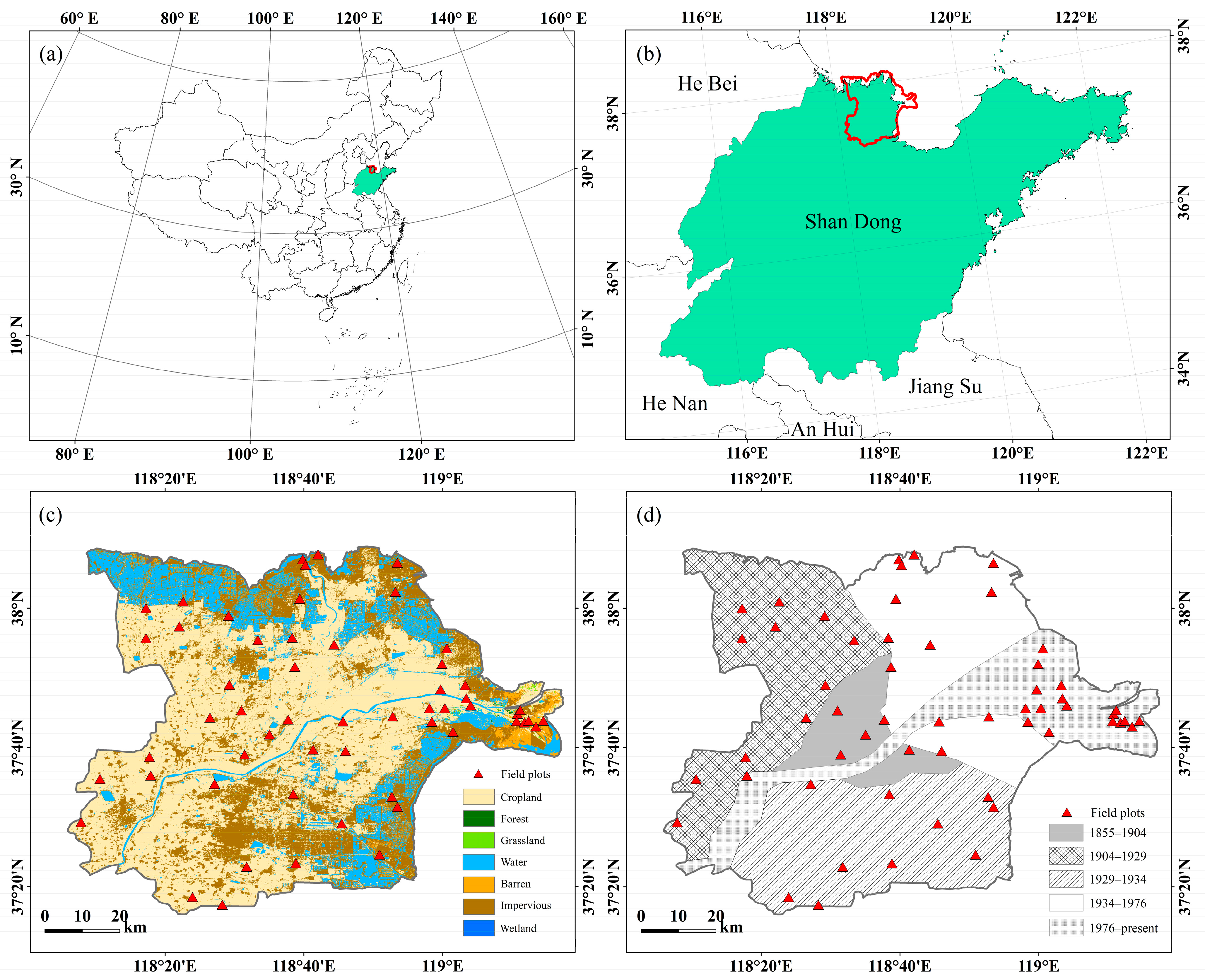
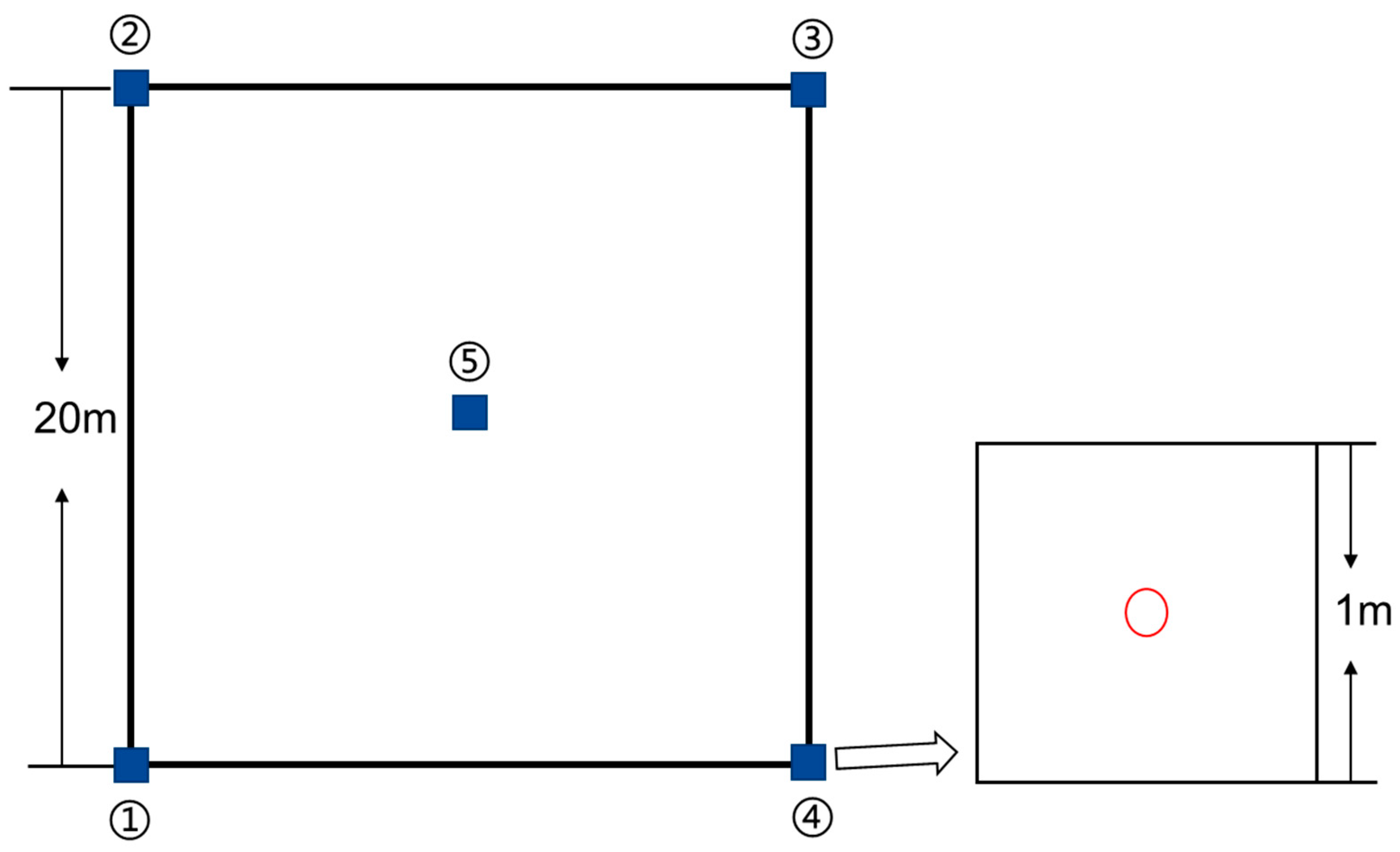
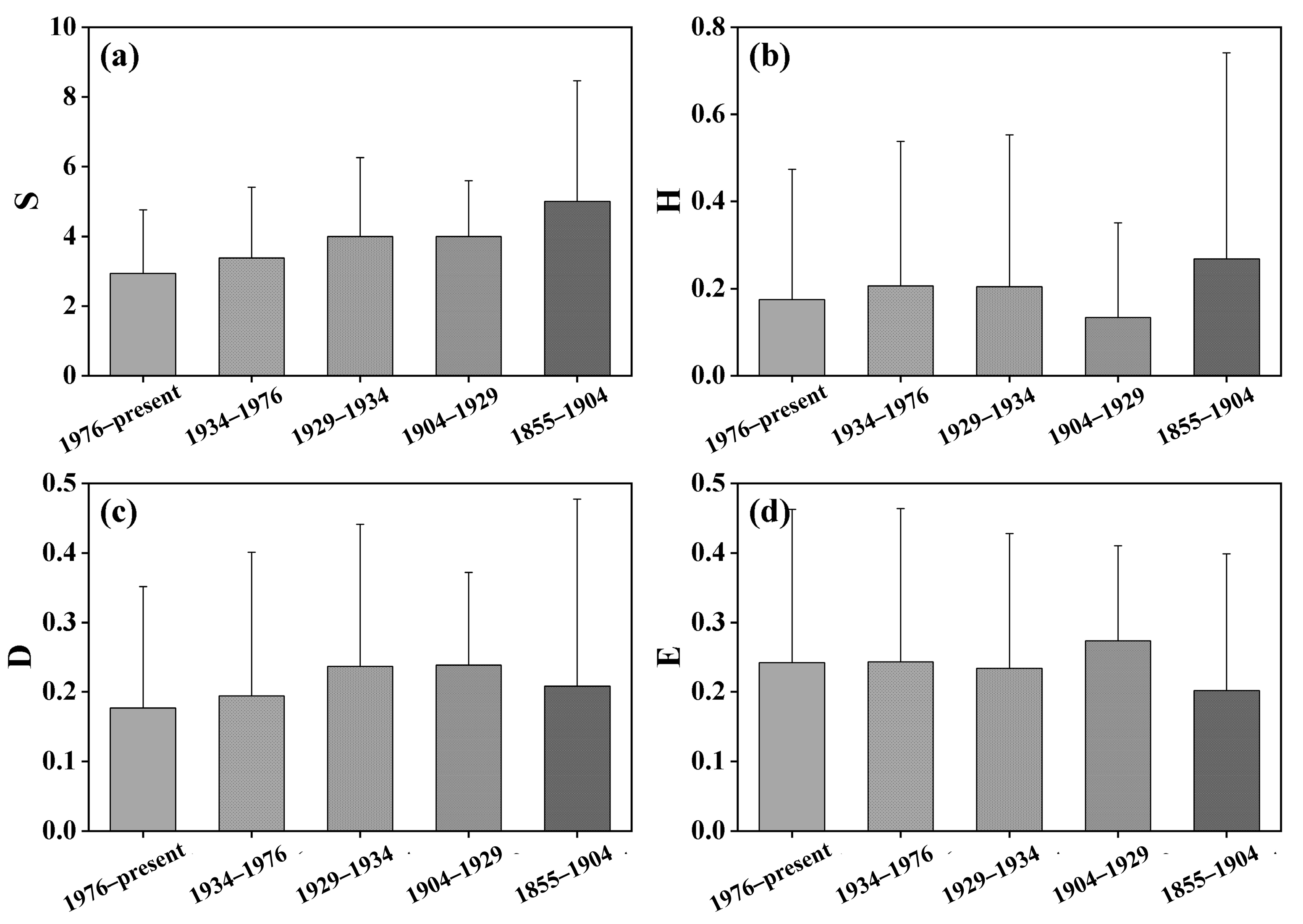
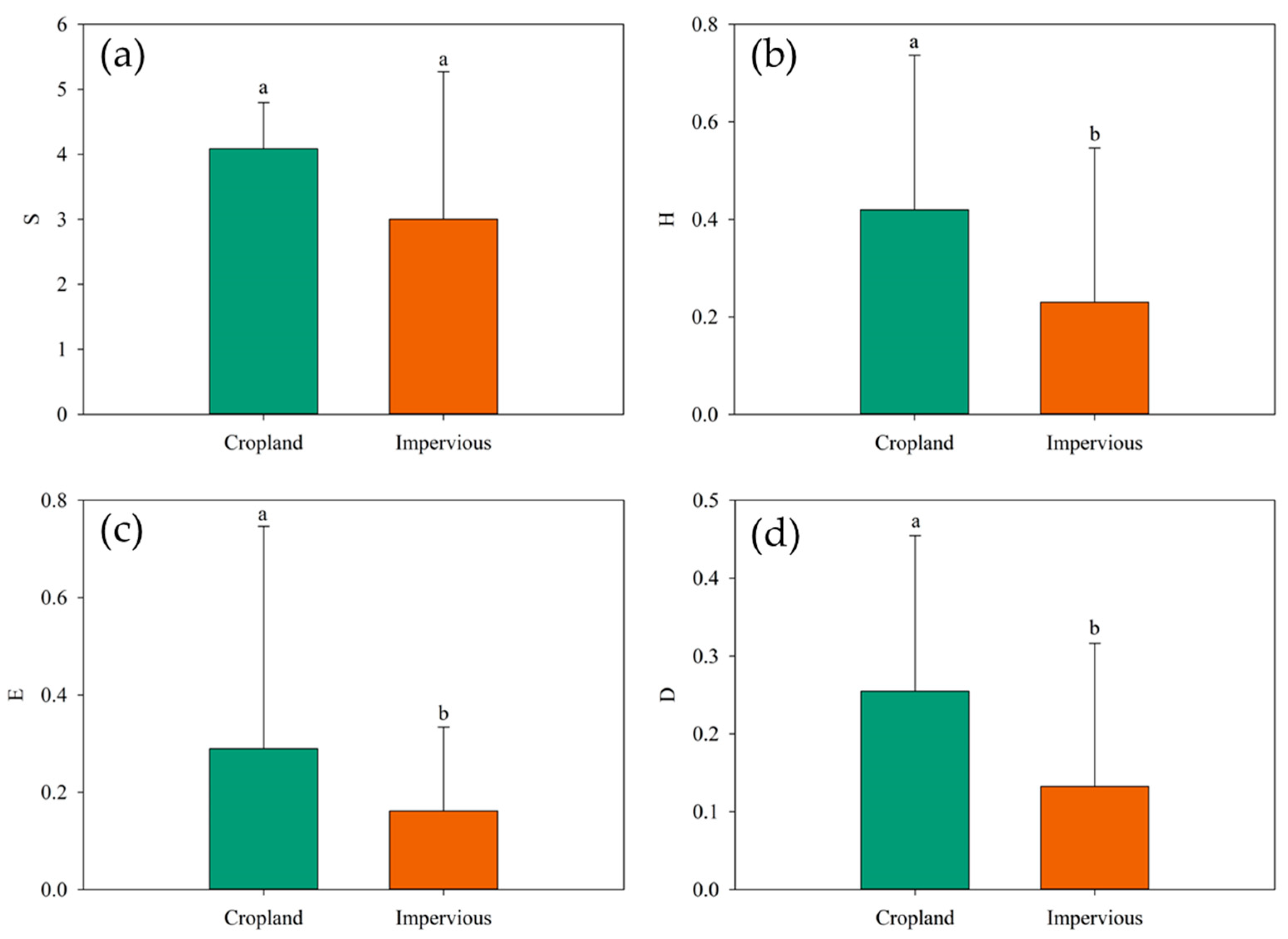
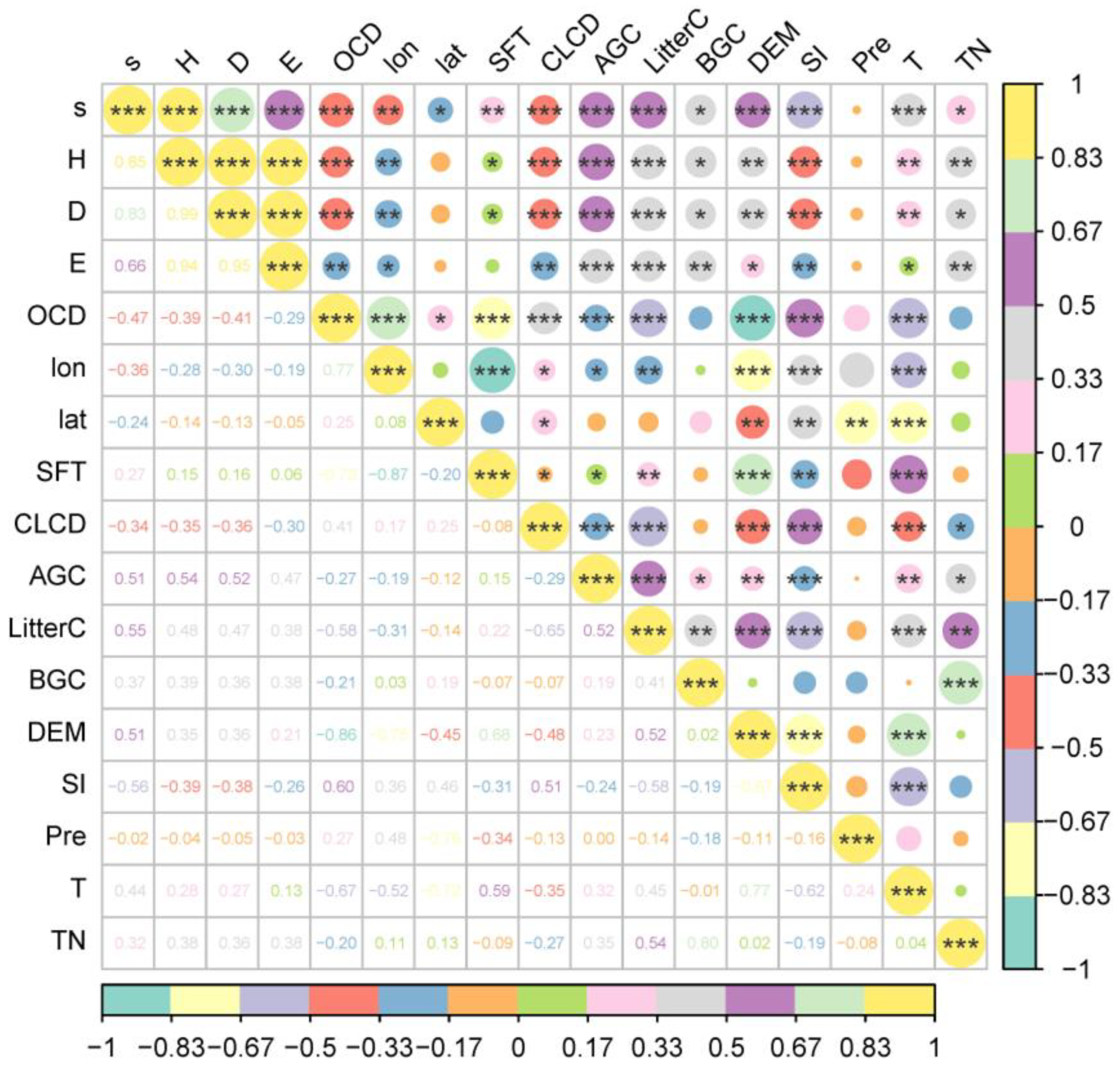
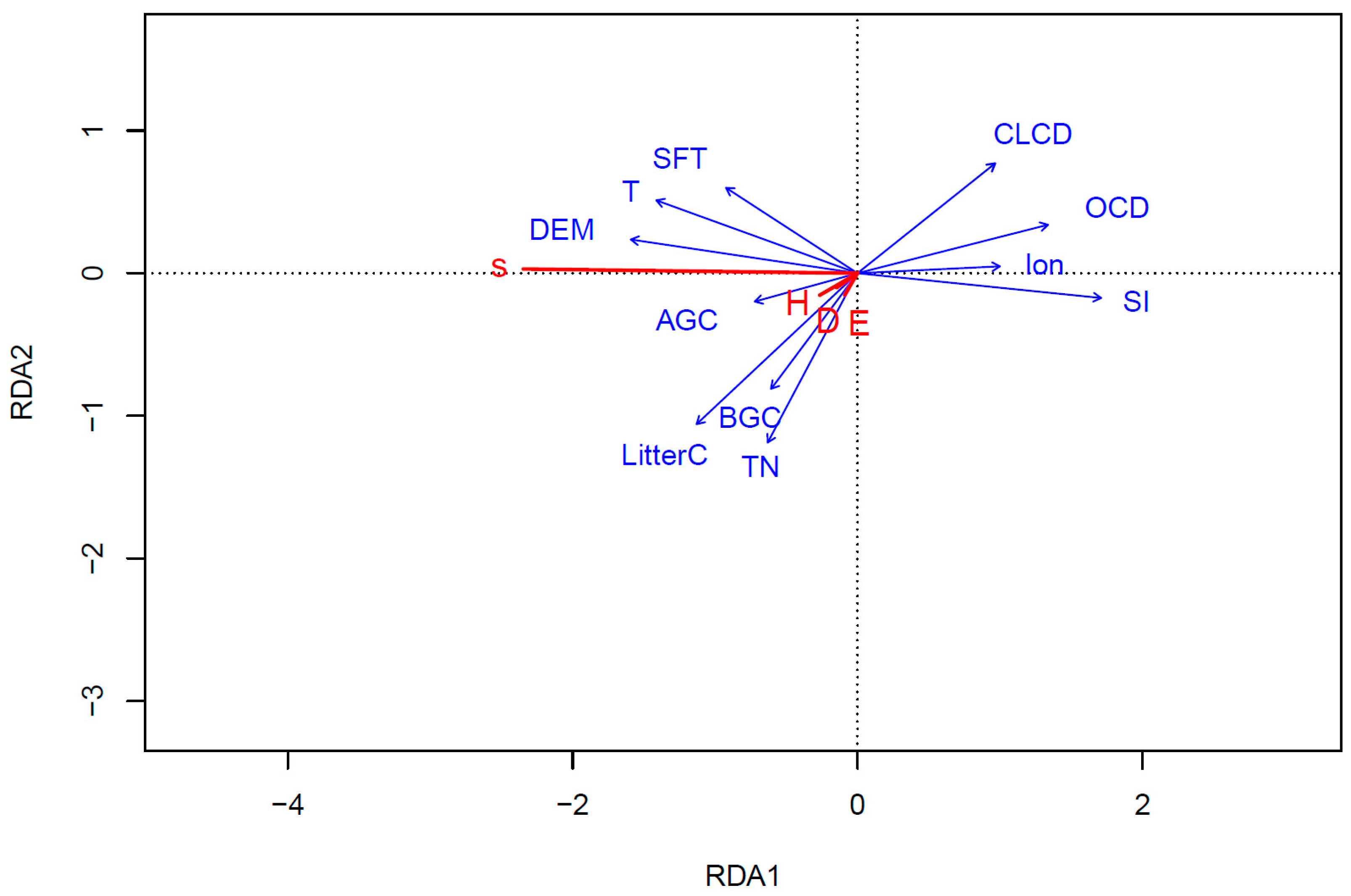
| Factors | Features | Unit | Abbr | Resolutions | Resources |
|---|---|---|---|---|---|
| Ecological stoichiometry of plant elements | Above-ground biomass carbon | Mg/ha | AGC | - | Field collection and laboratory testing |
| Litter carbon content | Mg/ha | LitterC | - | ||
| Below-ground biomass carbon | Mg/ha | BGC | - | ||
| Total nitrogen content | Mg/ha | TN | - | ||
| Soil properties | Soil formation time | Year range | SFT | - | Xue [46] |
| 0–5 cm soil organic carbon density | dg/kg | OCD | 250 m | SoilGrids250m 2.0 | |
| Salinity index | - | SI | 10 m | Sentinel-2 remote sensing image data inversion | |
| Environment variables | Longitude | Degree | lon | - | Field GPS recording |
| Latitude | Degree | lat | - | ||
| Annual China Land Cover Dataset | - | CLCD | 30 m | Yang and Huang [45] | |
| Temperature | °C | T | 0.0035° | Meteorological station data inversion | |
| Precipitation | mm | Pre | |||
| Digital elevation model | m | DEM | 30 m | Copernicus DEM GLO-30 |
| Factors | OCD | lon | lat | SFT | CLCD | AGC | LitterC |
|---|---|---|---|---|---|---|---|
| VIF | 6.17 | 14.26 | 29.48 | 7.41 | 2.38 | 1.27 | 3.74 |
| Factors | BGC | DEM | SI | Pre | T | TN | |
| VIF | 2.66 | 6.42 | 2.64 | 21.08 | 13.29 | 2.03 |
| Factors | OCD | lon | SFT | CLCD | AGC | LitterC | BGC | DEM | SI | T | TN |
|---|---|---|---|---|---|---|---|---|---|---|---|
| VIF | 5.67 | 6.41 | 5.42 | 2.32 | 1.26 | 3.65 | 2.66 | 6.38 | 2.56 | 3.63 | 1.96 |
| Factors | RDA1 | RDA2 | R2 | p |
|---|---|---|---|---|
| OCD | 0.999 | 0.037 | 0.160 | 0.006 ** |
| lon | 0.994 | −0.109 | 0.091 | 0.077 |
| SFT | −0.877 | 0.480 | 0.116 | 0.034 * |
| CLCD | 0.905 | 0.425 | 0.105 | 0.047 * |
| AGC | −0.999 | −0.053 | 0.047 | 0.279 |
| LitterC | −0.860 | −0.511 | 0.158 | 0.010 ** |
| BGC | −0.713 | −0.701 | 0.062 | 0.152 |
| DEM | −0.972 | 0.235 | 0.247 | 0.001 *** |
| SI | 0.979 | −0.206 | 0.279 | 0.001 *** |
| T | −0.936 | 0.353 | 0.219 | 0.001 *** |
| TN | −0.527 | −0.850 | 0.108 | 0.045 * |
Disclaimer/Publisher’s Note: The statements, opinions and data contained in all publications are solely those of the individual author(s) and contributor(s) and not of MDPI and/or the editor(s). MDPI and/or the editor(s) disclaim responsibility for any injury to people or property resulting from any ideas, methods, instructions or products referred to in the content. |
© 2024 by the authors. Licensee MDPI, Basel, Switzerland. This article is an open access article distributed under the terms and conditions of the Creative Commons Attribution (CC BY) license (https://creativecommons.org/licenses/by/4.0/).
Share and Cite
Xu, Z.; Li, R.; Dou, W.; Wen, H.; Yu, S.; Wang, P.; Ning, L.; Duan, J.; Wang, J. Plant Diversity Response to Environmental Factors in Yellow River Delta, China. Land 2024, 13, 264. https://doi.org/10.3390/land13030264
Xu Z, Li R, Dou W, Wen H, Yu S, Wang P, Ning L, Duan J, Wang J. Plant Diversity Response to Environmental Factors in Yellow River Delta, China. Land. 2024; 13(3):264. https://doi.org/10.3390/land13030264
Chicago/Turabian StyleXu, Zhen, Renqiang Li, Wenjun Dou, Hui Wen, Shulin Yu, Pan Wang, Lehua Ning, Jiaquan Duan, and Jichun Wang. 2024. "Plant Diversity Response to Environmental Factors in Yellow River Delta, China" Land 13, no. 3: 264. https://doi.org/10.3390/land13030264
APA StyleXu, Z., Li, R., Dou, W., Wen, H., Yu, S., Wang, P., Ning, L., Duan, J., & Wang, J. (2024). Plant Diversity Response to Environmental Factors in Yellow River Delta, China. Land, 13(3), 264. https://doi.org/10.3390/land13030264







